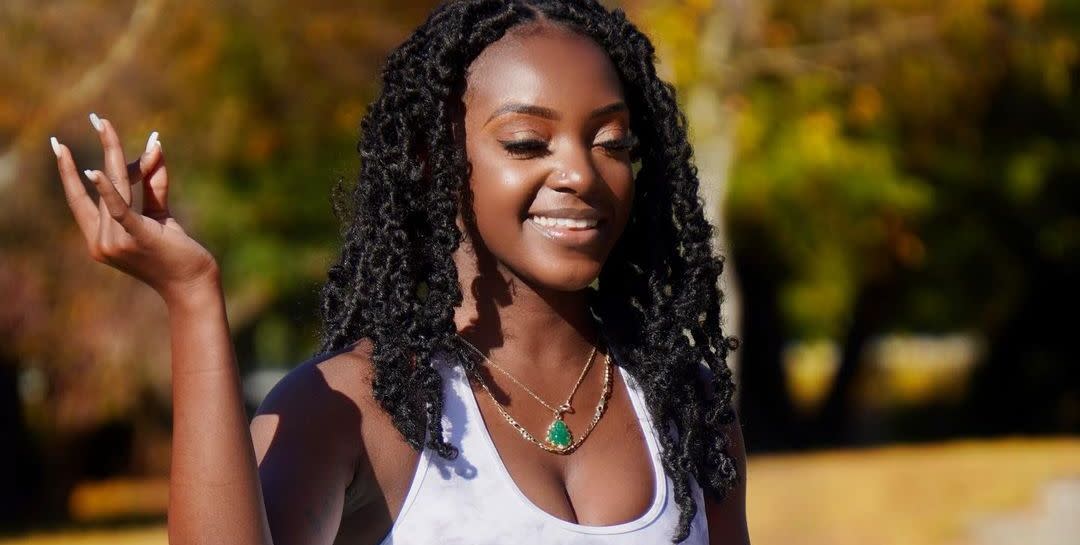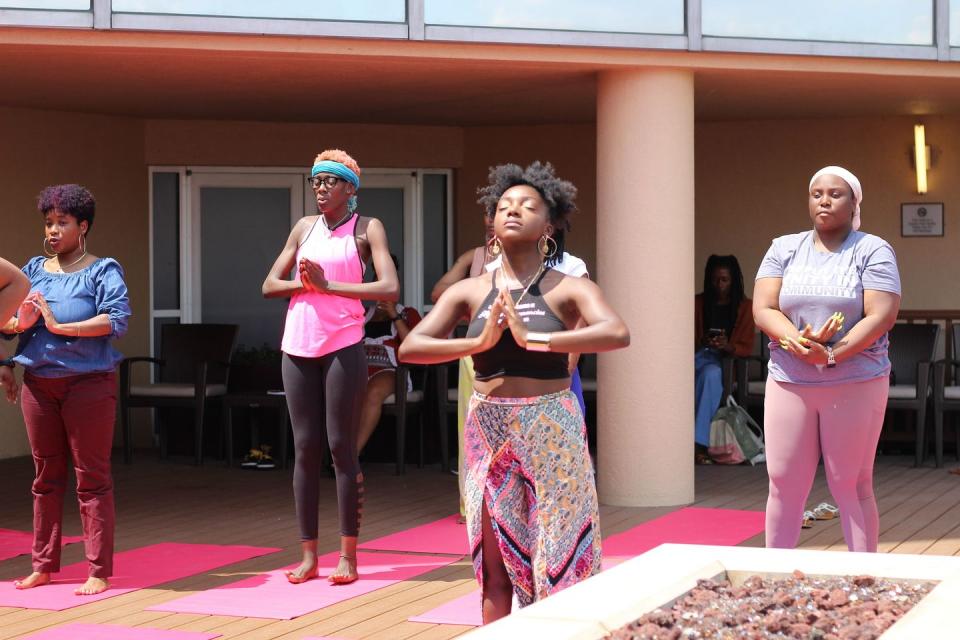My Anxiety Symptoms Once Took Control of My Life. Meditation Set Me Free.

Chare’A Smith sat down for her first meditation session as an eight year old in elementary school. But she didn’t realize just how much she’d need the practice until she was diagnosed with depression and anxiety in college.
Smith was first introduced to mindfulness meditation—the practice of watching your thoughts, feelings, and sensations without judgment—in the second grade. “I wasn’t necessarily a troubled kid, but sometimes I had a lot of anger,” Smith recalls. “I remember being a little confused about it, like, Why we gotta sit and be quiet? But with more consistency, I started to be able to observe myself and became more aware of what I was actually feeling, like, You’re not angry—you’re actually sad.”
In the fall of 2012, when Smith left her home in the south suburbs of Chicago for Indiana University in Bloomington, she suddenly found herself “running around every waking hour” as a science major, president of her university’s chapter of the National Association for the Advancement of Colored People (NAACP), a member of the Alpha Kappa Alpha Sorority, and an employee at the financial aid office.
The anxiety started small. First, she struggled to finish papers to hit tight deadlines. Then she skipped an awards ceremony, a moment where she should have been honored for her hard work as a leader on campus, because she was afraid of speaking in front of people. Before major exams or class projects were due, bouts of panic struck where she couldn’t breathe. “I kept telling myself, Just breathe, just breathe, just breathe,” she remembers.
Smith knew she needed help when she broke down crying in the middle of a class in 2016. At the time, she and her classmates were writing response essays after reading Ta-Nehisi Coates’ Between the World and Me, a book of letters to the author’s 15-year-old son in which he, as a Black man in America, tries to make sense of racial injustice and the death of a friend shot and killed by a policeman. Smith had recently lost one of her cousins to gun violence. She hadn’t been able to make it home for the funeral.
“I remember looking down and I literally could not write the paper,” Smith says. “It was bringing forth so much trauma.” She had always been an overachiever, but after failing to turn in this paper, her anxiety snowballed, and she struggled to keep up in other classes, too. “I went to the mental health facility on campus and told them, There’s something wrong with me. I don’t know what it is, but I’m not able to function.”
Asking for help
That day, a psychiatrist diagnosed Smith with anxiety and depression. He prescribed her an antidepressant called mirtazapine (Remeron SolTab) and later suggested she take alprazolam (Xanax), a type of sedative in a class of drugs known as benzodiazepines, for her anxiety. But Smith decided against it because she had heard that it could be addictive for some people. (In fact, the Food and Drug Administration added a safety warning to benzodiazepines in September 2020 due to risks of abuse, misuse, addiction, physical dependence, and withdrawal reactions).
Smith also began to see a therapist on campus once a week. But otherwise, she tried to keep her struggles to herself. “It was a silent battle because I felt embarrassed to tell anyone what I was going through,” she says. “I’m a very private person, and particularly in a marginalized community, people can feel shame about experiencing mental health problems.”
Although Smith didn’t tell her professors exactly what was going on with her, she did ask one for support as she embarked on this new journey. As it turned out, the same professor who had assigned the essay Smith couldn’t write, Maria Hamilton Abegunde, Ph.D., a visiting lecturer in the African American and African Diaspora Studies department, was also a meditation instructor and yoga teacher.
When conversations during her office hours spilled over, the two often walked together to a nearby building where Abegunde led mindfulness meditation sessions. Smith gradually began to join in. “She really took me under her wing,” she says.
Four months into treatment, Smith weaned herself off of antidepressants because she wasn’t noticing a therapeutic effect. At the same time, she dialed up her meditation practice.
Meditation as a form of therapy
Currently, the first-line treatments for anxiety and depression are psychotherapy as well as medication. But some patients, like Smith, consider mindfulness meditation a form of treatment in itself.
“We don’t know yet how mindfulness meditation might compare to other treatments for anxiety disorders,” says Elizabeth Hoge, M.D., a Harvard-trained psychiatrist and director of the Anxiety Disorders Research Program at the Georgetown University School of Medicine in Washington, D.C.
Previously, a 2018 study led by Dr. Hoge published in the journal Psychiatry Research had people living with anxiety disorders, such as generalized anxiety disorder (GAD) or panic disorder (PD), spend eight weeks taking stress management classes or a mindfulness-based stress reduction (MBSR) course, which incorporates practices like breath awareness, body scan meditations, and yoga, with two and a half hours of instruction each week. Those who learned how to meditate not only said they felt less stressed when they had to give an impromptu speech in front of an audience, but they also had a lower biological stress response according to blood tests.
“It seems that in anxiety disorders, mindfulness meditation helps people to experience their thoughts differently,” says Dr. Hoge. “Rather than acting on the thought or trying to get away from the thought, they would see the thought for what it is—which is just a thought—and not try to push it away or grab onto it.” Additionally, learning how to be less judgmental and more compassionate toward yourself is a fundamental part of the process as well, she says.
The path to healing
For her part, Smith says it took time to reap the benefits of meditation. “At first, I just didn’t feel so down all the time about doing simple things,” she says.
After a while, though, she began to notice helpful shifts in her thought processes and mindset. Problems at work became an opportunity to learn. Would-be confrontations with a friend, a chance to develop her communication skills.
“I think it goes back to what I learned as a child,” she says. “You’re able to observe things from an outside perspective rather than just reacting as things happen to you.”
The next semester, Smith had the best grades she’d ever had. Once trapped in an anxiety spiral, she felt like she was finally able to be her “full self” again.
“Meditation set me free,” she says. “It allowed me to see that the presence of anxiety is normal, but to live as a prisoner with your anxiety is optional.”
A lifelong practice
After Smith graduated from college, she struggled to manage a 9-5 job in sales, her first business, and a nonprofit organization—and her anxiety surged again.
“I began to understand that if I wanted to elevate within my career, my wellness journey would simultaneously need to elevate as well,” she says. Smith set a goal to level up from meditating three days a week as needed to six days a week on a set schedule.
Today, Smith works as a full-time yoga and meditation instructor and entrepreneur. She’s the founder and owner of two businesses: Worthy of Evolving, a self-care shop for the mind, body, spirit and home, and Ye’ Self Care, a meditation and wellness service that provides workshops for individuals and businesses. She also heads a nonprofit called Melanin Girl’s Club, which aims to make self care (including meditation) accessible and inclusive for women and communities of color in urban areas.

How to meditate through anxiety and depression
If you’re interested in trying out meditation to help manage symptoms of anxiety or depression, it’s best to start by connecting with a mental healthcare provider such as a therapist who can tailor a treatment plan to your needs, says Dr. Hoge. This is especially the case if you’re dealing with traumatic memories which could arise during meditation and can be hard to navigate on your own, she notes.
While there are plenty of meditation apps to choose from, Smith and Dr. Hoge both recommend finding a teacher who can guide you through the practice in real life, at least at first. It’s normal to sometimes experience a surge in difficult emotions you’ve been ignoring—including depression and anxiety—when you sit in silence for the first time in a long time.
“But that’s not necessarily a bad thing,” says Dr. Hoge. “Certain emotions are going to come up when we leave a space for them to come up. And I think that’s part of why meditation has been so popular—people realize they have feelings that they need to process through, like unresolved grief, that they don’t experience unless they leave space for them, such as while meditating.” However, this can be unnerving or even make you worry that meditation isn’t working without someone there to talk it out with you.
Many drop-in mindfulness meditation classes are available free of charge, and your healthcare provider can help you enroll in an MBSR class. (You can also find certified MBSR teachers around the world in this online directory from the Mindfulness Center at Brown University.)
It’s important to understand that mindfulness meditation isn’t a quick fix. It’s more like a muscle to build and maintain which takes time and commitment like exercising or learning a new instrument, says Dr. Hoge. It’s also not to be confused with relaxation techniques which, while likely helpful for people with anxiety disorders, are different from mindfulness meditation. When you meditate, the goal is to watch your thoughts with openness and a nonjudgmental stance—which isn’t necessarily relaxing, she explains.
As you go, “realize that your change, breakthrough, or whatever you want to receive from your practice is not going to come overnight,” says Smith. “For me, meditation is now my relief—I enjoy it and want to do it—and the days when I don’t want to do it are the days when I know I really need it.”
Go here to join Prevention Premium (our best value, all-access plan), subscribe to the magazine, or get digital-only access.
You Might Also Like

